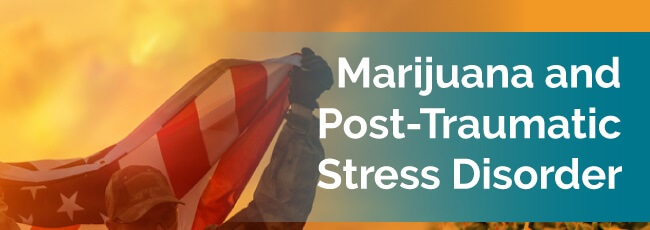
Post-traumatic stress disorder, known colloquially as PTSD, is an anxiety disorder caused by the experience of traumatic events. Combat, car accidents and abuse are just a few examples of events that can lead to PTSD. A person has PTSD if the initial reaction to the stress of these events, which includes fear, nausea, dizziness, depression and/or sleep disturbances, lasts for several weeks or more. The symptoms can last for decades.
The three main characteristics of PTSD are re-living of traumatic events, increased arousal and avoidance. Re-living can manifest as flashbacks or nightmares and may be triggered by reminders of the events, which leads to avoidance of those reminders. Increased arousal is a state of hyper-vigilance, which can manifest as paranoia. These PTSD behaviors and experiences are often accompanied by acute anxiety, nausea, avoidance of activities that were once commonplace, anger, self-medicating and relationship sabotage.
PTSD can be alleviated or eliminated with cognitive behavioral therapy, but it is not always successful. While therapy can help some people with PTSD, it’s not always an effective treatment. For example, prolonged exposure, one form of CBT, often has a 20 percent drop-out rate at Veterans Affairs (VA) hospitals.
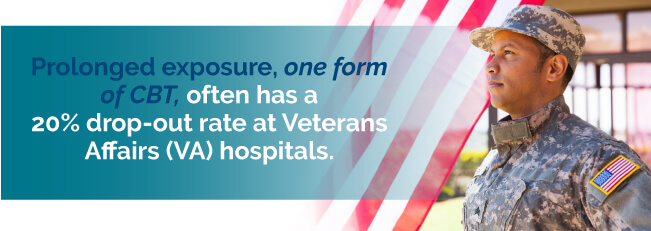
Medication can be used to treat the anxiety, sleep disturbances and depression that accompany PTSD, but these too are not always successful. The medications most commonly prescribed to help people with PTSD don’t effectively treat the entire condition. Plus, there is a risk for unpleasant side effects with most of the medicines commonly prescribed.
Since the current treatments don’t always work, doctors and researchers are continually on the lookout for more effective options. One of those options is medical cannabis for post-traumatic stress disorder.
Studies have shown that medical marijuana can help treat PTSD symptoms in even treatment-resistant cases. Cannabinoid receptors are located in various places throughout the body and brain, so both mental and physical symptoms can be altered with medical marijuana treatment.
Although the majority of states now have a medical marijuana law on the books, a number of legal issues have kept doctors and researchers from fully examining the effect weed can have on people with PTSD. That’s beginning to change, as more and more studies are coming out of the U.S. and Canada. Most notably, the FDA approved a study on the effects of medical marijuana on veterans with PTSD in 2017.
Depending on the results of the study, a cannabis-based treatment specifically for post-traumatic stress disorder might be available on the market as soon as 2023. The product would be based on the strains of cannabis the researchers include in their study and wouldn’t necessarily impact the type of pot sold at dispensaries or change the federal government’s classification of marijuana.
The FDA-approved study is the first of its kind because it allows researchers to actually give veterans pot to smoke. Up until now, studies on medical marijuana and post-traumatic stress disorder have all been observational. That means researchers were aware of the fact that the study participants were smoking weed or using it in other ways. But they couldn’t hand out joints or edibles themselves.
One study looked at patients who signed up for New Mexico’s Medical Cannabis Program. New Mexico was the first state to include PTSD as a condition eligible for medical marijuana. The study aimed to analyze the effectiveness of medical marijuana for post-traumatic stress disorder symptoms.
It involved administering the Clinician-Administered Posttraumatic Scale for DSM-IV, or CAPS, to gauge patients’ symptoms. When patients were using cannabis, the majority had a more than 75 percent reduction in symptoms compared to when they were not using cannabis.
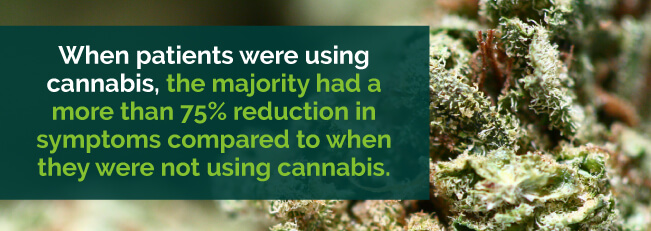
The Canadian Forces Health Services Operational Trauma and Stress Support Centre in Ottawa conducted an outpatient study on medical marijuana for the treatment of PTSD between 2004 and 2006. They studied 47 individuals with PTSD-related nightmares who were given a nabilone, “an endocannabinoid receptor agonist,” to treat those nightmares. The study found that 72 percent of the patients had far fewer nightmares or stopped having them altogether over the course of their treatment. Some of the patients also saw benefits in their amount of sleep and their waking PTSD symptoms, such as flashbacks and hypervigilance.
PTSD sufferers often experience anxiety-related nausea and vomiting. Nabilone is already used as treatment for nausea and vomiting in cancer patients. Therefore, nabilone may have several benefits for PTSD sufferers beyond what the above study has shown. However, study of the use of nabilone for treatment of PTSD is thus far limited.
Other studies have sought to figure out why some people are more susceptible to PTSD than others and have come to interesting conclusions. For example, a 2013 study at New York University’s Langone Medical Center looked closely at the endocannabinoid system in the brain. The researchers found that people with PTSD had considerably lower levels of anandamide, a neurotransmitter, than individuals who did not have PTSD. Additionally, those with PTSD had higher numbers of cannabinoid receptors, which are activated by anandamide and other neurotransmitters.
When cannabinoid receptors are activated, they work to help suppress or impair memory and also work to help lower anxiety. In other words, those receptors are there to help you forget the bad and scary things in your life. When they aren’t functioning correctly, your bad, fearful memories linger, and you end up with higher levels of anxiety.
Some of the compounds in cannabis can activate the same receptors as anandamide, acting as a sort of replacement for the neurotransmitter. So far, some studies have examined how effective cannabidiol (CBD) and tetrahydrocannabinol (THC) are at activating the cannabinoid receptors in the brain. One study found that CBD given to rats at the same time as a painful sensation caused the rats to forget the source of the pain.
On its own, THC can contribute to increased feelings of anxiety in people, whether they have PTSD or not. But strains of pot that contain both it and CBD seem particularly helpful in quelling memories and reducing anxiety.
Most evidence suggests that the therapeutic use of cannabis can significantly improve the quality of life for both those who have PTSD and their families. Medical marijuana is not a cure. However, when the plant activates the body’s cannabinoid receptors, it provides incredible relief for a few of the most debilitating symptoms associated with the disorder, including:
Studies show both negative and positive results for the use of marijuana for anxiety and depression. Some individuals with PTSD will feel a significant lessening of these symptoms. Others may feel an increase in them, as well as an increase in paranoia. However, the pills that doctors prescribe for the treatment of PTSD have similar opposing effects. For example, selective serotonin reuptake inhibitors can increase symptoms of depression and anxiety. In fact, some of these drugs can produce suicidal thoughts and behaviors. No conclusive causal relationship has been found between medical marijuana and suicide.
Studies show, and the Department of Veterans Affairs agrees, that self-medication — substance abuse to treat illness — can be caused by post-traumatic stress disorder. When prescribed medications do not help, sufferers ingest drugs like marijuana and alcohol to alleviate their symptoms.
Although the VA hasn’t yet conducted studies examining the role marijuana can play in helping people with PTSD, it has found a connection between veterans seeking health care from the VA and veterans with cannabis use disorder.
According to the VA, 40,000 veterans with PTSD who were seen by the VA in 2014 were diagnosed with cannabis use disorder. The reason for that is likely two-fold. People with PTSD are likely to self-medicate when standard treatments for the condition aren’t effective. While some turn to alcohol to help improve sleep and calm anxieties, others choose to smoke pot.
Because marijuana is not accepted as a treatment for PTSD in most areas, this self-medication is often done without the knowledge of the sufferers’ therapists and physicians. But when people self-medicate with pot, they often don’t know what they are smoking, how potent the strain of marijuana is or even what compounds might be in the strain. That can mean they might be using a form of cannabis that will be less helpful for their PTSD than a strain that would be available with a recommendation from a marijuana doctor and purchased from an approved marijuana dispensary.
Additionally, the VA has pointed out that people with PTSD are more likely to struggle to stop using marijuana than people who smoke and who don’t have PTSD. For that reason, it’s even more important that access to medical guidance be available to people living with PTSD who wish to use pot to manage their symptoms. If PTSD sufferers were allowed prescription cannabis, the risk for side effects, overuse, legal complications and stigma can be reduced or eliminated.
Certain medications used for the treatment of PTSD can cause severe adverse reactions. There is also treatment-resistant PTSD. Patients who cannot take the medications prescribed for PTSD are left with therapy only, which may not work. In some of these cases, medical marijuana could alleviate symptoms, thus reducing the risk of suicide, which is high in PTSD, and increasing quality of life.
Medical marijuana isn’t approved for post-traumatic stress disorder in all states that have medical marijuana laws, but it does qualify in a number of states. Contact MarijuanaDoctors.com to learn more, to search for a doctor in your area and to see if PTSD qualifies for medical cannabis in your state.
There are several ways to ingest marijuana for post-traumatic stress disorder, including:
To get the most therapeutic benefit from cannabis to improve PTSD symptoms, it’s recommended that patients start with low to moderate doses.
There are numerous strain options available that may help alleviate a patient’s PTSD symptoms. Before choosing one, however, you need to understand the difference between strains high in THC and those which are CBD dominant.
When using cannabis to treat PTSD, high-CBD strains provide mood-stabilizing effects, which is especially useful if a patient feels mentally or emotionally unstable. Those strains with large amounts of THC are generally most effective in the evening or at night to aid a restful night’s sleep.
It’s also important to note that CBD does not produce the “high” associated with marijuana. In fact, CBD dominant strains with less than one percent THC content don’t have any psychoactive side effects.
With that in mind, here are five strains which offer incredible benefits for patients with PTSD:
Medical marijuana taken with proper monitoring by a mental health professional ensures that potential side effects that are contrary to the patient’s goals are observed, and the medication is adjusted accordingly. Self-medication does not provide such a fail-safe, though it is the only marijuana treatment option for thousands of PTSD sufferers.
In the event that there are adverse effects to marijuana use, such as psychosis, paranoia and increased anxiety, in PTSD sufferers, doctors may not know whether it is the PTSD or drug use if the marijuana is not obtained with a doctor recommendation.
Post-traumatic stress disorder (PTSD) is a severe anxiety disorder that can develop after exposure to any event that results in psychological trauma. Symptoms include:
Some people develop PTSD after they experience a dangerous event, have a scary experience or suffer a shock. When a person has PTSD, they feel under threat or at risk, even when there is no obvious danger.
Depending on the person, PTSD can develop right after a trauma. However, it can also develop months or even years later. The symptoms of the condition are usually grouped into several categories. To be diagnosed with PTSD, you need to experience at least one of each type of symptom and need to have those symptoms for at least a month.
PTSD affects nearly eight million Americans, according to the Anxiety and Depression Association of America. Although anyone can develop post-traumatic stress disorder, the condition affects women much more than men.
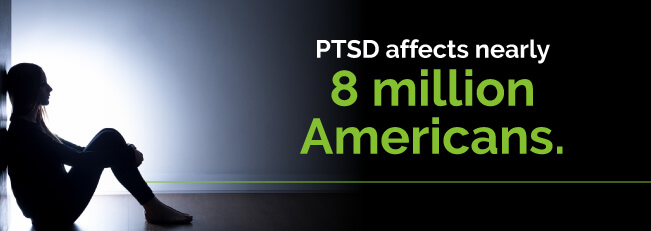
According to the National Center for PTSD, about 10 percent of women will develop it at some point. Only about four percent of men develop PTSD, despite the fact that 60 percent of men experience trauma at some point during their lifetimes, compared to 50 percent of women.
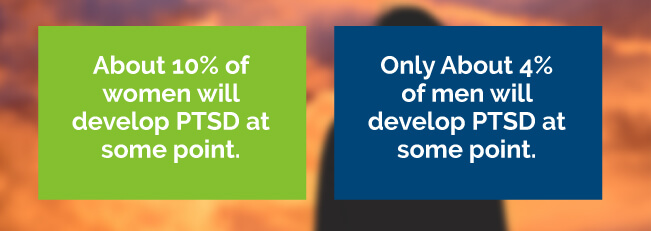
Some factors can make one person more likely to suffer from PTSD than another. For example, a person might have a family history of depression or anxiety that increases their risk of developing the condition. Some people experience more stress or trauma during their lives than others as well. The way a person’s brain regulates certain chemicals or a person’s natural temperament can also influence whether they are more likely to develop PTSD.
The number of traumatic events a person experiences can also increase their risk for developing PTSD. Trauma such as experiencing abuse during childhood, witnessing combat, being a victim of sexual assault or other violence and experiencing a natural or human-made disaster can all trigger PTSD.
One of the groups most susceptible to suffering PTSD is the military. Soldiers who see combat often experience horrible events and can be severely affected as a result. According to the U.S. Department of Veteran Affairs, the percentages of combatants who suffer from PTSD are fairly similar among veterans who served in the Vietnam War, Gulf War, Operation Iraqi Freedom and Operation Enduring Freedom.
Approximately 15 percent of Vietnam War vets had been diagnosed with the condition at the time of the last study, which was performed in the late 1980s. About 12 percent of Gulf War vets had PTSD, while the Department estimated between 11-20 percent of Operation Iraqi Freedom and Operation Enduring Freedom were affected.
Once a battle ends, it is not unusual for a soldier to feel angry, confused or scared or go through several other emotions as well. While it is normal, if the feelings don’t dissipate, they can become disruptive to a person’s daily life. Veterans who have been diagnosed with this condition have seen or experienced something terrible that caused them to fear for their lives or feel helpless. Many of them improve with time, but others need intensive help to regain a sense of normalcy. About one in three people who experience PTSD will typically have symptoms for an extended period.
Engaging in battle is not the only way a soldier can develop PTSD. Some vets have issues involving the politics of war, the location of the battle, the type of enemy they faced and more.
An event known as military sexual trauma (MST) can also be a factor in developing PTSD. MST can occur during wartime, training or peacetime and can take several forms, including sexual harassment and sexual assault. More than half of female veterans have reported being sexually harassed while serving, and nearly a quarter reported being assaulted.
MST isn’t restricted to women, though. Around 38 percent of male veterans reported being victims of sexual harassment. Surprisingly, the Department reports that more than half of all veterans who experience some sort of military sexual trauma are men. That is most likely because more men than women serve in the armed forces.
During and after a trauma, the human body does what it can to protect itself from further harm. The stress response, also known as “fight or flight,” originally developed to help people make rapid decisions when in potentially life-threatening situations.
In many cases, people can bounce back from their initial fight or flight response and continue to go about their daily lives without issue. But some people end up developing post-traumatic stress disorder, and the condition can last for months or years after the initial triggering event.
Some examples of experiences that can cause PTSD include:
There are those, however, who can experience similar traumas and not struggle with PTSD. The reason some develop the condition while others do not may have a more scientific explanation. Those with post-traumatic stress disorder appear to have lower levels of anandamide. This neurotransmitter activates natural cannabinoid receptors which help suppress negative memories. When anandamide levels are low, the individual could be more prone to developing the symptoms associated with PTSD.
PTSD is not a new disorder, as people have been suffering trauma in some form or another for all of human history. For example, some would argue that King Henry IV displays symptoms of the disorder in Shakespeare’s plays. In the 1700s, a doctor named Josef Leopold from Austria attempted to describe what he termed “nostalgia” in soldiers. In the late 1800s, the writer Charles Dickens witnessed a train accident and would go on to experience symptoms including anxiety and insomnia.
During World War I, the term “shell shock” was used to describe what is now better described as PTSD. By World War II, shell shock was replaced with the term “Combat Stress Reaction.” The phrase “Post-Traumatic Stress Disorder” didn’t appear until the 1980s, with the publication of the third volume of the Diagnostic and Statistical Manual of Mental Disorders.
The four categories of PTSD symptoms include:
When children develop PTSD, it is common for them to have slightly different symptoms from adults. The type of symptoms a child displays largely depends on their age. Very young children under the age of six might wet the bed, act out, re-enact the triggering event or lose the ability to speak. Older children typically have symptoms similar to those of adults.
The symptoms of PTSD are ongoing and long-lasting. It is fairly common for people to experience one or more symptoms after a trauma. But if those symptoms fade or resolve after a few weeks, a person is likely to have had acute stress disorder. Symptoms that last for more than a month usually signal PTSD.
You can divide current, standard treatments for post-traumatic stress disorder into two categories. The first is therapy, also called psychotherapy. The second is medication. Some people benefit from combining treatments, while others might see the greatest benefit from therapy or the greatest benefit from medicines. It’s also occasionally the case that standard treatments aren’t sufficient enough to help a patient.
A technique known as cognitive behavioral therapy (CBT) is one of the most commonly used for PTSD. The goal of CBT is often to get a person with PTSD to confront the trauma, understand it and change the way they think about or approach it.
Depending on the goals of the therapy, CBT can involve one or more components. Often, a technique known as exposure therapy is part of the process. During exposure therapy, you are asked to visit or imagine the place or situation where your trauma occurred. The goal is to have you recall the trauma but in a space where you feel protected and safe. Confronting your trauma can help you learn to cope with negative feelings that arise and can help you become desensitized to it.
Since going back to the actual scene of the trauma or re-creating the situation in real life isn’t always plausible, therapists often use virtual reality devices to help their patients return to the setting of the trauma.
Cognitive restructuring is another standard component of CBT. Often, a person’s memories of trauma can become distorted, causing them to feel guilt or to misremember the main aspects of the situation. During cognitive restructuring, a patient works with a therapist to re-examine the event and to get a more realistic viewpoint on what occurred.
Along with therapy or instead of therapy, a doctor might prescribe medication to help a patient with PTSD. There are four main types of medications used to treat PTSD — Selective Serotonin Reuptake Inhibitors (SSRIs), Serotonin-Norepinephrine Reuptake Inhibitors (SNRIs), Prazosin and anti-anxiety medicines. Here’s some information on each:
If you have post-traumatic stress disorder, medical marijuana could be the solution to relieving many of your debilitating symptoms. This safe and effective treatment is available in a few states with a doctor recommendation.
We want to connect you with qualified physicians in your area. Use our database to find a doctor near you. Or, if you already have your medical marijuana ID card, you can also use our site to locate a nearby cannabis dispensary.
Find A Doctor Find A Dispensary


Please allow us to access your location to find local dispensaries.
VIEW ALL DISPENSARIES ➔